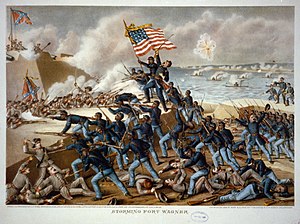Second Battle of Fort Wagner
| Second Battle of Fort Wagner (Second Assault on Morris Island) |
|||||||
|---|---|---|---|---|---|---|---|
| Part of the American Civil War | |||||||
 54th Massachusetts Regiment charging towards Fort Wagner |
|||||||
|
|||||||
| Belligerents | |||||||
|
|
|
||||||
| Commanders and leaders | |||||||
|
Quincy A. Gillmore Truman Seymour John A. Dahlgren |
P.G.T. Beauregard William B. Taliaferro |
||||||
| Units involved | |||||||
| See Union Order of Battle | See Confederate Order of Battle | ||||||
| Strength | |||||||
| 5,000 troops 6 Ironclads |
1,800 troops | ||||||
| Casualties and losses | |||||||
|
1,515 total (246 killed; 880 wounded; 389 missing/captured) |
174 total (36 killed; 133 wounded; 5 missing/captured) |
||||||
The Second Battle of Fort Wagner, also known as the Second Assault on Morris Island or the Battle of Fort Wagner, Morris Island, was fought on July 18, 1863, during the American Civil War. Union Army troops commanded by Brig. Gen. Quincy Gillmore, launched an unsuccessful assault on the Confederate fortress of Fort Wagner, which protected Morris Island, south of Charleston Harbor. The battle came one week after the First Battle of Fort Wagner.
Fort Wagner, or Battery Wagner as it was known to the Confederates, controlled the southern approaches to Charleston Harbor. It was commanded by Brigadier General William B. Taliaferro. An attempt was made on July 11 to assault the fort, the First Battle of Fort Wagner, but it was repulsed with heavy losses to the attackers because of artillery and musket fire. Brig. Gen. Quincy Gillmore intended to repeat his assault, but first executed feints to distract the Confederates' attention, the Battle of Grimball's Landing on July 16. Gillmore also ordered an artillery bombardment of the fort. The fort was on a very narrow island so the Union could only assault the fort with one regiment at a time.
The approach to the fort was constricted to a strip of beach 60 yards (55 m) wide with the ocean to the east and the marsh from Vincent's (now Bass) Creek to the west. Upon rounding this defile, the Union Army was presented with the 250-yard south face of Fort Wagner, which stretched from Vincent's creek to the sea. Surrounding the fort was a shallow moat riveted with sharpened palmetto logs, as abatis, and the moat on the seaward side had planks with spikes positioned beneath the water. The armament of Fort Wagner on the night of July 18 consisted of one 10-inch seacoast mortar, two 32 lb. carronades, two 8-inch shell guns, two 32 lb. howitzers, a 42 lb. carronade, and an 8-inch seacoast mortar on the land face. Company A of the 1st South Carolina Artillery also had two guns positioned outside of Wagner's southern face by Vincent's creek to provide enfilading fire. The sea face of Wagner was armed with one 32 lb. carronade, one 10-inch Columbiad, and two 12 lb. howitzers. The garrison of Battery Wagner consisted of the 1st South Carolina Artillery, the Charleston Battalion, the 31st North Carolina, and the 51st North Carolina.
...
Wikipedia
